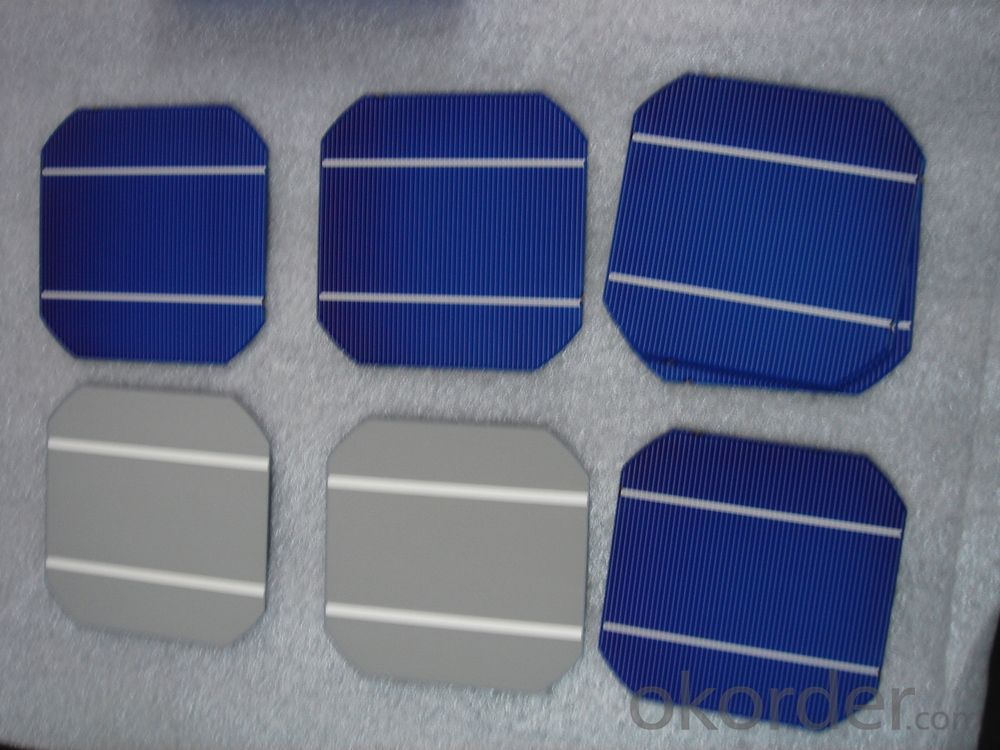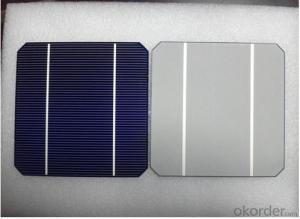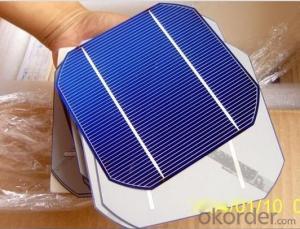125 Mono Solar Cell 5 Inch Efficiency 2.85W-3.5W
- Loading Port:
- Shanghai
- Payment Terms:
- TT or LC
- Min Order Qty:
- 500 pc
- Supply Capability:
- 10000 pc/month
OKorder Service Pledge
OKorder Financial Service
You Might Also Like
| Quick Details | |||||
| Material: | Monocrystalline Silicon | Bus Bar: | 2 | Grade: | A |
| Size: | 125*125mm | Max. Power: | 2.85w-3.5W | Efficiency: | 18.6-22.87 |
| Packaging & Delivery | |
| Packaging Detail: | Typical package for one box is 1,000 cells.These cells are sealed in paper boards every 100 PCS.Gross weight per unit box shall be around 16kg |
5'' High Efficiency Mono Solar Cell 125*125 mm



Our Advantage
Reason:
We enjoy exclusive channel to get solar cells at more competitive price from Sunpower,Neo solar,Motech,Gintechetc.
We signed long term purchase contract with Taiwan tier 1 solar cell manufacturers,including but not limited to Neo solar,Motech,Gintech,AUO,then we can purchase unsorted solar cells in bulk from them and sort these unsorted solar cells into same efficiency,same pattern,same color by our own QA team. We call them Grade A-.
Quality :
These sorted solar cells have same electrical performance with Taiwan Grade A solar cells,only difference is the negligible superficial defect.
We can guarantee that they are better than grade A solar cells from tier 1 solar cell manufacturers in China mainland.
Description
1.Mechanical Specification:
Product Mono-crystalline silicon solar cell
Dimension 125 mm x 125 mm ± 0.5 mm
Thickness 200 μm ± 30 μm
Front 1.4mm bus bar(silver),blue anti-reflecting coating(silicon nitride)
Back 2.0 mm wide soldering pads(silver) Back surface field (aluminum)
2.Electrical Properties
| Efficiency (%) Pmpp (W) Vmpp(V) lmpp (A) Voc(V) lsc(A) |
| 19.40-19.50 3.01 0.54 5.61 0.64 5.93 |
| 19.30-19.40 2.99 0.54 5.58 0.64 5.92 |
| 19.20-19.30 2.97 0.54 5.55 0.64 5.92 |
| 19.10-19.20 2.96 0.53 5.54 0.64 5.90 |
| 19.00-19.10 2.94 0.53 5.51 0.64 5.89 |
| 18.90-19.00 2.93 0.53 5.50 0.63 5.87 |
| 18.80-18.90 2.91 0.53 5.47 0.63 5.86 |
| 18.70-18.80 2.90 0.53 5.46 0.63 5.85 |
| 18.60-18.70 2.88 0.53 5.43 0.63 5.84 |
| 18.40-18.60 2.85 0.53 5.40 0.63 |
Packaging & Shipping
1. Payment term: T/T in advance (W/U for sample order)
2. Lead time: It depends on your quantity. Usually we will send sample within 1-3 working days.
3. Shipping will be made via EMS, DHL, TNT, UPS, Air, Sea etc. shipment
4. Others: If you have special specifications and requirements, we will do different offer as you required.
Our Services
Pre sale:
1.Our sales representative and engineer work together to answer your questions and offer solution for free
2.We choose the best product for you to make sure it worth its real value
3.We design the best solution with good perfomance for you,manwhile save every cent of your money.
After sale:
We can change broken solar cell for you or compensate for your lost.
Solar cells are electronic semiconductor components, by means of which sunlight can be converted into electric energy. The semiconductor body can consist, for instance, of silicon or a III-V compound such as gallium arsenide and is provided on its front side facing the radiation source with a p-n junction of large area by means of diffusion.
A method for manufacturing solar cells comprising growing semiconductor whiskers on a substrate, comprising:
(a) Providing a substrate which favors growth or germination of whiskers;
(b) Depositing a plurality of localized areas of an agent in which the semiconductor material is soluble;
(c) Growing whiskers of said semiconductor material by means of the Vapor Liquid Solid (VLS) method at said areas;
(d) Doping the whiskers with one of a p or n doping material; and
(e) Subsequently thereto doping the surface region of said whiskers up to a depth which approximately corresponds to the diffusion length of the charge carriers pairs with the other of a P or n doping material.
Estimating the manufacturing cost of purely organic solar cells
we estimate the manufacturing cost of purely organic solar cells. We find a very large range since the technology is still very young. We estimate that the manufacturing cost for purely organic solar cells will range between $50 and $140/m2. Under the assumption of 5% efficiency, this leads to a module cost of between $1.00 and $2.83/Wp. Under the assumption of a 5-year lifetime, this leads to a levelized cost of electricity (LEC) of between 49¢ and 85¢/kWh. In order to achieve a more competitive COE of about 7¢/kWh, we would need to increase efficiency to 15% and lifetime to between 15–20 years.
Manufacturing Solar Cells
First, silicon raw material is melted and re-cast to remove impurities. The cast silicon is then stabilized in its multicrystalline form. These castings, called "ingots," are then cut into blocks. Next, the ingots are sliced into wafers.( Depending on the type of silicon used, p-type or n-type silicon wafers may be produced). After layering the p-type or n-type wafers, the material is capable of generating electricity from sunlight. Electrodes are attached to the wafers to conduct the flow of electricity. This is called a photovoltaic cell, or "solar cell."
- Q:What is the best way to deal with surplus solar cells abandoned after burning?
- The surplus of solar cells can be very useful or useless at all. Totally depend on how people try to apply it to the new construction work.
- Q:Can solar cells be used for powering remote communication towers?
- Yes, solar cells can be used for powering remote communication towers. Solar cells convert sunlight into electricity, which can be used to power various devices including communication towers. This is especially useful for remote areas where access to the power grid is limited or non-existent. Solar-powered communication towers offer a sustainable and cost-effective solution for maintaining connectivity in these remote locations.
- Q:Can solar cells be used in space heating systems?
- Yes, solar cells can be used in space heating systems. Solar cells can convert sunlight into electricity, which can then be used to power heating systems. This can be done through the use of solar thermal collectors or by converting the electricity generated by the solar cells into heat using electric heaters.
- Q:Can solar cells be used to power street lights?
- Yes, solar cells can be used to power street lights. Solar-powered street lights utilize photovoltaic panels to convert sunlight into electricity, which is then stored in batteries. This stored energy is used to power the street lights during the night, providing an eco-friendly and cost-effective lighting solution for public spaces.
- Q:What is the role of silicon in solar cells?
- Silicon is a crucial component in solar cells as it acts as a semiconductor material that can convert sunlight into electricity. When exposed to sunlight, silicon absorbs photons, which in turn excite the electrons, allowing them to flow and generate an electric current. It also forms the basis of the p-n junction, an essential structure within solar cells that separates the positive and negative charges, facilitating the flow of electricity. Overall, silicon's properties make it ideal for harnessing solar energy and converting it into usable electricity.
- Q:How do solar cells perform in desert environments?
- Solar cells perform very well in desert environments due to the abundance of sunlight and high temperatures. The dry and clear conditions in deserts allow solar panels to receive maximum sunlight, resulting in optimal energy production. Additionally, the heat can actually enhance the efficiency of solar cells, as they work more efficiently at higher temperatures. However, it is important to regularly clean the panels to remove dust and sand accumulation, which can reduce their performance.
- Q:What kind of products can be considered as the solar cell products?
- Here are some of the solar cell products I can recall for now:Solar notebook, Solar-powered calculator, Solar-powered desalination unit, Solar-powered radio, Solar-powered refrigerator.
- Q:Can solar cells be used in smart home automation systems?
- Yes, solar cells can be used in smart home automation systems. Solar cells can generate electricity from sunlight and can be integrated into the smart home system to power various devices and sensors. This allows for energy-efficient and sustainable operation of the automation system, reducing reliance on conventional power sources and lowering electricity costs.
- Q:How do solar cells perform in areas with high levels of pollen?
- Solar cells can be affected by high levels of pollen in certain ways. Pollen, when accumulated on the surface of solar panels, can reduce their efficiency by blocking sunlight from reaching the cells. This reduction in efficiency can result in a decrease in the overall energy generation of the solar panels. Hence, it is important to regularly clean and maintain solar panels in areas with high pollen levels to ensure optimal performance.
- Q:How do solar cells perform in regions with high levels of humidity and rainfall?
- Solar cells can still perform well in regions with high levels of humidity and rainfall. While humidity may slightly decrease the efficiency of solar cells, modern designs and materials are developed to withstand these conditions. Additionally, rainfall can actually be beneficial as it helps to clean the solar panels, removing dust and dirt that may accumulate on the surface. Overall, solar cells can still generate electricity effectively in regions with high humidity and rainfall, although their performance may be slightly affected.
1. Manufacturer Overview |
|
|---|---|
| Location | |
| Year Established | |
| Annual Output Value | |
| Main Markets | |
| Company Certifications | |
2. Manufacturer Certificates |
|
|---|---|
| a) Certification Name | |
| Range | |
| Reference | |
| Validity Period | |
3. Manufacturer Capability |
|
|---|---|
| a)Trade Capacity | |
| Nearest Port | |
| Export Percentage | |
| No.of Employees in Trade Department | |
| Language Spoken: | |
| b)Factory Information | |
| Factory Size: | |
| No. of Production Lines | |
| Contract Manufacturing | |
| Product Price Range | |
Send your message to us
125 Mono Solar Cell 5 Inch Efficiency 2.85W-3.5W
- Loading Port:
- Shanghai
- Payment Terms:
- TT or LC
- Min Order Qty:
- 500 pc
- Supply Capability:
- 10000 pc/month
OKorder Service Pledge
OKorder Financial Service
Similar products
New products
Hot products
Related keywords




























